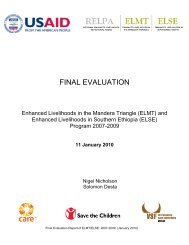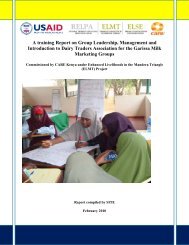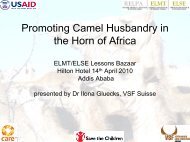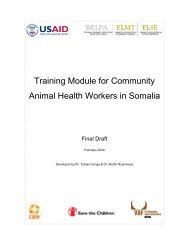Impact Assessment of the Community Animal Health System in ...
Impact Assessment of the Community Animal Health System in ...
Impact Assessment of the Community Animal Health System in ...
You also want an ePaper? Increase the reach of your titles
YUMPU automatically turns print PDFs into web optimized ePapers that Google loves.
Contents<br />
Executive Summary..............................................................................................................................................i<br />
1. Introduction ........................................................................................................................................... 1<br />
1.1 Private veter<strong>in</strong>ary practice <strong>in</strong> pastoralist areas................................................................... 1<br />
1.2 The VSF Suisse/ELMT project ............................................................................................... 1<br />
2. Methods .................................................................................................................................................. 2<br />
2.1 Study design ............................................................................................................................ 2<br />
F<strong>in</strong>ancial susta<strong>in</strong>ability .................................................................................................. 2<br />
Quality <strong>of</strong> CAHW treatments ....................................................................................... 2<br />
2.2 Data collection ......................................................................................................................... 3<br />
Key <strong>in</strong>formant <strong>in</strong>terviews.............................................................................................. 3<br />
Methods with CAHWs .................................................................................................. 3<br />
Proportional pil<strong>in</strong>g to estimate case fatality rate (CFR) ............................................ 3<br />
2.3 Sampl<strong>in</strong>g method and sample sizes ..................................................................................... 4<br />
3. Results ................................................................................................................................................... 5<br />
3.1 F<strong>in</strong>ancial performance <strong>of</strong> pharmacies .................................................................................. 5<br />
3.2 Number <strong>of</strong> CAHW treatments and <strong>in</strong>come......................................................................... 7<br />
3.3 Disease report<strong>in</strong>g by CAHWs ............................................................................................... 7<br />
3.4 Quality <strong>of</strong> CAHW treatments................................................................................................ 8<br />
Case fatality rates <strong>in</strong> sheep and goats.......................................................................... 8<br />
Case fatality rates <strong>in</strong> camels .......................................................................................... 9<br />
Case fatality rates <strong>in</strong> cattle............................................................................................. 9<br />
3.5 Areas for improvement ........................................................................................................ 11<br />
4. Discussion............................................................................................................................................. 12<br />
4.1 Methodological issues .......................................................................................................... 12<br />
Tim<strong>in</strong>g <strong>of</strong> <strong>the</strong> assessment ............................................................................................ 12<br />
Disease diagnosis, recall issues and case fatality rates............................................ 12<br />
4.2 <strong>Impact</strong> assessment f<strong>in</strong>d<strong>in</strong>gs................................................................................................. 13<br />
F<strong>in</strong>ancial susta<strong>in</strong>ability <strong>of</strong> CAHWs l<strong>in</strong>ked to private pharmacies ........................ 13<br />
Quality <strong>of</strong> CAHW treatments ..................................................................................... 14<br />
Disease report<strong>in</strong>g and l<strong>in</strong>ks to government.............................................................. 16<br />
Use <strong>of</strong> veter<strong>in</strong>ary drugs by pastoralists..................................................................... 17<br />
5. Conclusions and Recommendations................................................................................................. 17<br />
Acknowledgements<br />
The community animal health (CAH) system covered <strong>in</strong> this report was funded by <strong>the</strong> United States Agency for<br />
International Development (USAID) through <strong>the</strong> Regional Enhanced Livelihoods <strong>in</strong> Pastoral Areas (RELPA)<br />
program, Enhanced Livelihoods <strong>in</strong> <strong>the</strong> Mandera Triangle (ELMT) activity. With<strong>in</strong> ELMT, Veter<strong>in</strong>aires sans<br />
frontieres Suisse (VSF Suisse) supported <strong>the</strong> CAH system. The participatory impact assessment was conducted<br />
follow<strong>in</strong>g a tra<strong>in</strong><strong>in</strong>g conducted <strong>in</strong> Garissa, Kenya. Both <strong>the</strong> tra<strong>in</strong><strong>in</strong>g and assessment were implemented by <strong>the</strong><br />
RELPA Pastoral Areas Coord<strong>in</strong>ation, Analysis and Policy Support (PACAPS) activity, implemented by <strong>the</strong><br />
Fe<strong>in</strong>ste<strong>in</strong> International Center, Tufts University. The assessment team acknowledges <strong>the</strong> <strong>in</strong>tellectual<br />
contributions <strong>of</strong> pastoralists and community‐based animal health workers <strong>in</strong> Geder, Wargudud, Kalwahil and<br />
Wangaydahan, and <strong>the</strong> valuable <strong>in</strong>formation provided by <strong>the</strong> Takaba and Wargudud private veter<strong>in</strong>ary<br />
practitioners and <strong>the</strong> Vet Agro Company <strong>in</strong> Nairobi. We also acknowledge <strong>the</strong> support <strong>of</strong> VSF Suisse expert, Dr.<br />
Simon Chuchu, and Mr. Anis Hassan, and <strong>the</strong> support <strong>of</strong> <strong>the</strong> CARE Takaba <strong>of</strong>fice. The PIA tra<strong>in</strong><strong>in</strong>g was assisted<br />
by Dr. Dawit Abebe <strong>of</strong> PACAPS and Mr. Charles Hopk<strong>in</strong>s <strong>of</strong> CARE Ethiopia; Dr. Andy Catley <strong>of</strong> PACAPS<br />
provided assistance with data analysis and edited <strong>the</strong> report.












